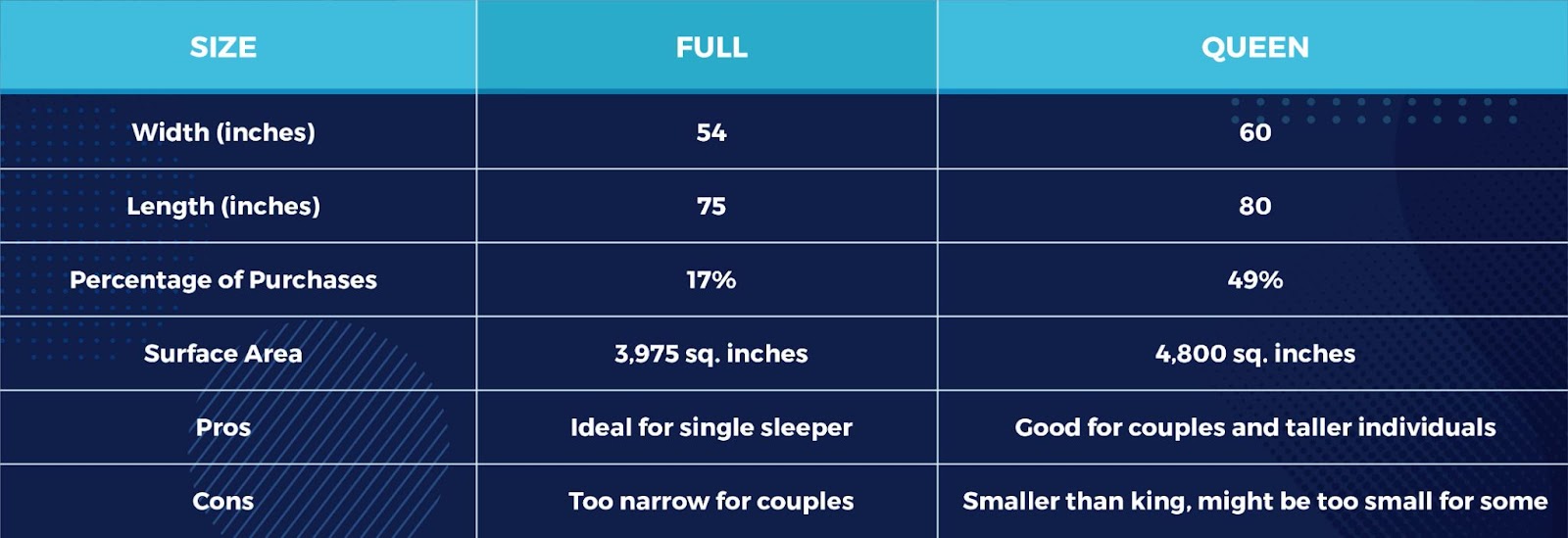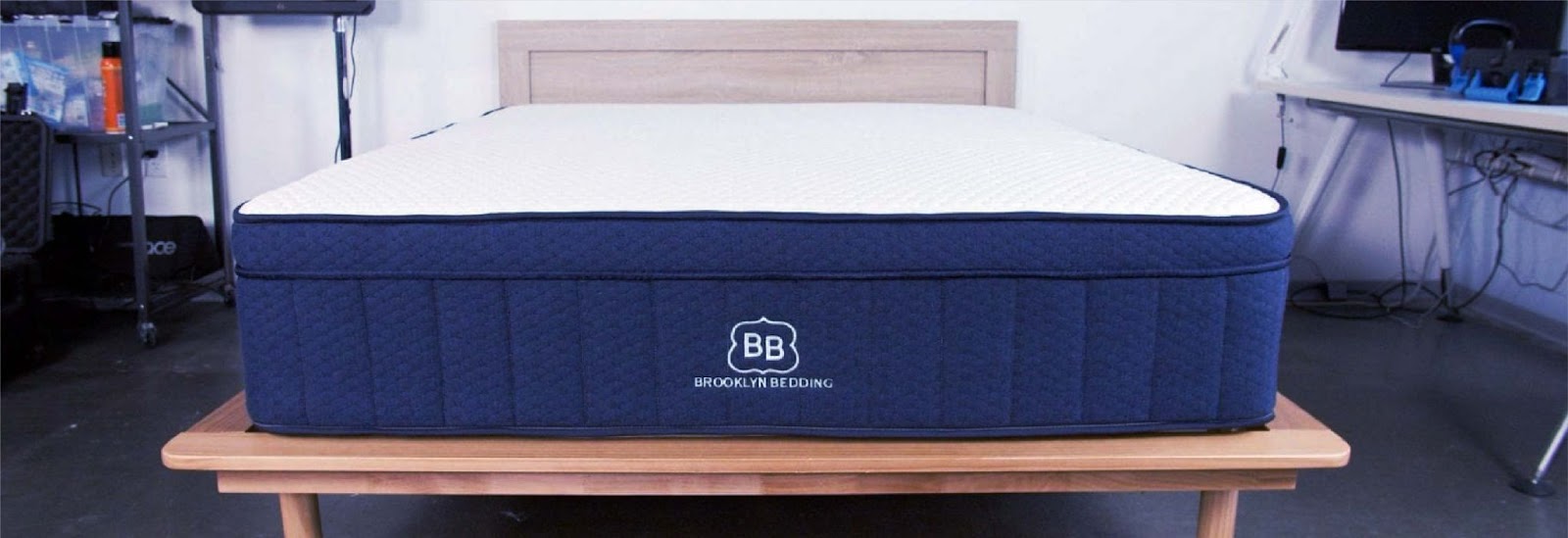Blog > Full Size vs. Queen Size Mattress – What’s Best in 2024
Blog > Full Size vs. Queen Size Mattress – What’s Best in 2024
There are multiple factors to consider when shopping for a mattress; materials, price, firmness, and one of the most important, size. You’ll want to select the right size for your home, body, and current sleeping arrangements. Two of the most common sizes shoppers choose from are sizes full—sometimes called a double bed—and Queen.
These two are very similar, yet often confused. This guide outlines and explains the difference between the sizes, explores the dimensions of each, gives a few recommendations, and more!
While similar in size, the key difference in full and queen sizes is the overall dimensions, width, and length. Even a small amount can make quite a difference, especially if you have limited space. This chart will briefly help you determine which option is the best for you.

When comparing measurements using the chart above, the queen sized mattress is larger than the full. The full 54 x 75 inches, while the queen bed is 60 x 80 inches. While the difference is subtle, a few mere inches can make all the difference depending on room size and your height. Queen mattresses are ideal for both single people who like more room in bed and for couples. Those who sleep alone will fare well with either option.
Full-sized mattresses are an excellent option because they provide a larger sleep surface than a Twin or Twin XL without taking up too much space in your bedroom. Mattresses this size will easily fit into any bedroom. Full size mattresses are also excellent options for growing kids, because they are small enough without being too large for kids yet will accommodate quick growth.
Along with full and queen sized mattresses, there are a few similar options that might work better for you. Here’s a rundown of a few other sizes.

A queen XL is four inches longer than the conventional queen size, measuring a total of 60 inches x 84 inches. While the four inches might not seem like much, it can make a difference for someone who is taller. This additional legroom, plus the fact this mattress is a smaller size than a king, are the main advantages of a queen XL mattress.

A full XL mattress has the same 54 inch width as a full mattress but is as long as a queen mattress. This size can be easily shared by two people, but if you’re used to a queen or king, it might be a little small. For taller people who sleep by themselves, a full XL would be a great option. However, this size is not easy to find.

The Olympic queen mattress is 6 inches wider than the regular queen. The extra 6 inches provides more sleeping area without taking up as much space as a king or California king mattress.

The California queen is longer than a regular queen but has the same width. This mattress is 84 inches long, the same width as the California king, and is perfect for those taller than 6 feet. If you or your spouse are on the taller side and can fit at least a queen mattress, a California queen might be a good fit.

Since a full size mattress is smaller, it will always cost less than a queen size mattress, regardless of brand or type. Along with the overall size of the mattress and whether it will fit in your home, accessories like pillows and sheets will cost more for a queen size mattress than a full size mattress.
While the upfront prices of a queen and full mattress are similar, it’s important to consider the additional costs like sheets. Here’s a comparison of full vs queen size mattress pricing among several popular brands at SleePare.

A cooling all-foam mattress with Open-Cell technology that allows for improved air circulation. This provides excellent bounce and contouring for a comfortable sleep.
Price (Queen): $895
Price (Full): $795

Purple's trademark grid layer promotes airflow and circulation, ensuring you don't overheat while sleeping. The open air design of the Purple Grid keeps you cool and adjusts to your sleeping posture.
Price (Queen): $1299
Price (Full): $1099

The Helix Midnight Luxe is one of the most comfortable mattresses on the market. The mattress was designed for side sleepers and provides zoned lumbar support to prevent pressure. Soft support keeps your shoulders pain-free while firm support aligns your hips and spine.
Price (Queen): $1949
Price (Full): $1649

Brooklyn Bedding’s Aurora is a hybrid mattress designed for comfort and support. Made with an advanced base of 1,032 individually encased Ascension X® coils, this mattress provides pressure relief and provides excellent motion transfer. Six layers of cooling and body contouring technology keep you cool and supported.
Price (Queen): $1599
Price (Full): $1749

WinkBeds is a newcomer to the online mattress industry and has become a top seller. The WinkBed is a hybrid innerspring hybrid mattress with a Euro pillow-top and gel-infused memory foam. It also includes extra support for those who suffer from sciatica and back pain.
Price (Queen): $1499
Price (Full): $1799

The size of your room will determine what size mattress will work the best for the space. Your bed is one of the focal points of your bedroom, so you will want it to fit. It’s important to remember that there will be other items in your room—like a nightstand or dresser—and you’ll want to make sure that all the furniture in your bedroom will fit without overcrowding.
When it comes to arranging your bed, consider the space beside your bed, or where you place your feet when you get out of bed. This should leave plenty of space for you to move around your room.
Based on your preferences and room size, a room measuring 10 ft x 10 ft will easily fit a queen size mattress and leave plenty of space for other furniture. Since a full bed is smaller, it may fit into smaller spaces, like a room measuring 10 ft x 9 ft. While the actual sizes of the mattresses aren’t much different, the frame for a queen-size mattress is larger than a full.
If you are living in a smaller apartment or a studio/loft, a full or queen size bed might be too large. In that case, it’s best to go with a smaller size mattress or arrange your furniture in a way that doesn’t overcrowd your room.

Both a full or queen size bed can be equally comfortable. Ultimately, what you find the most comfortable is your own preference. Even the same brand and style of mattress will feel the same if they are different sizes. If you are taller, sleep with a partner, or want more space to stretch out, a queen size mattress will be the most comfortable to you. On the other hand, if you’re shorter and don’t need as much room when sleeping, a full size bed will be fine for you.
After reviewing the sizes and other details of a queen versus a full size mattress, it might seem that the bigger (queen) is better. However, that isn’t always the case, depending on your circumstances. Here’s a list of the pros and cons of a full bed.
Pros:
Full size beds are smaller and require fewer resources to manufacture, resulting in lower costs.
A full bed is ideal for a guest room since it can comfortably sleep a couple or a single visitor. Having a full sized bed in your guest bedroom will make sure your guests are more comfortable than having them sleep on a sofa.
It's the same length as a twin, but wider, giving your child plenty of space to move and change positions while sleeping.
Cons:
For taller individuals, a full size bed is not the best fit. If you're taller than 5'5", your legs may dangle over the edge of the bed, making it difficult to get comfortable.
Larger individuals need more room to move about and feel comfortable while sleeping. If you and your spouse are heavier, a full bed could be too little for you.

While queen size mattresses are the most popular size purchased and will fit in many sized rooms and types of homes. This size might not be the best choice. Here are a few pros and cons of a queen size mattress.
Pros:
Since queen mattresses are the most popular size, it is unlikely that mattresses will sell out in this size, same for bedding and other accessories.
Couples are more likely to choose a queen size mattress over a full one because they are much larger and provide more room. On a queen size mattress, couples can move freely without disturbing your partner.
If you're taller than 5 feet, an additional five inches in length may make a big difference in your comfort level.
Cons:
Larger mattress sizes require more materials during production, which is why they cost more. For some shoppers, a queen size mattress might not fit their budget.
Queen mattresses are larger than full size mattresses and will be much larger when unpacking. They are also heavier in general, which makes it more difficult to move.

Before finally narrowing down your choice between full or queen size mattress, it’s important to remember and consider a few things:
If you sleep with a partner, either a significant other or a child, a queen will be the best choice for couples because of the larger size. However, if you are a single sleeper, either size should work fine.
Smaller beds are usually less expensive, so choosing a full will save you money. While prices vary by manufacturer, you should expect to pay $100-$300 less for a full mattress than a queen, even if they are the same type of mattress.
While the sizes of a queen or full are similar, the widths are noticeably different. A queen size will be the best option for taller individuals, as they are 80 inches long. A full is 75 inches long and the extra five inches on a queen can make quite a difference.
When it comes to sleeping position, the size can make an impact as well. Back and stomach sleepers who tend to stretch out will benefit the most from a longer mattress. For side sleepers who often curl up their bodies, the length won’t matter as much.
Both full and queen size mattresses are fairly easy for in-shape adults to move. Full size beds, which have about 15% less surface area than a queen, are much easier to maneuver around corners and up staircases.
While the difference between a full and a queen size mattress is subtle, depending on which one you select can make a difference to your overall sleep and comfort. Even with the closeness in measurements, those few inches between them can make all the difference, especially if you are tall or share your bed with a partner.
Along with your sleep position, size preference, or whether you sleep with a partner, the size of your room is another important factor to consider when choosing between a full or queen size bed. If you have a limited space, it's best to choose a smaller mattress (full) so you have more space. If space is not so much of an issue, a queen size bed is an excellent choice.
Still looking for other mattress sizes or recommendations? Visit our website or stop by one of our showrooms to find the best mattress for you!

 Showrooms
Showrooms
Meet The Author:
Shanir Kol
Shanir Kol, founder and CEO of SleePare, pioneered the “Try and Buy” model in eCommerce, enhancing mattress shopping by combining in-store trials with online purchases. Launching in 1999, his company focuses on customer satisfaction and eco-friendly practices, aiming to minimize mattress waste and expand sustainably.